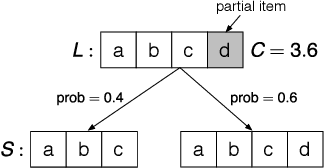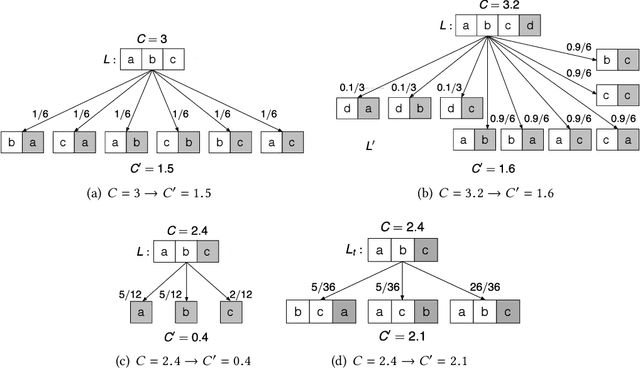Yuanyuan Tian
MiMo: Unlocking the Reasoning Potential of Language Model -- From Pretraining to Posttraining
May 12, 2025Abstract:We present MiMo-7B, a large language model born for reasoning tasks, with optimization across both pre-training and post-training stages. During pre-training, we enhance the data preprocessing pipeline and employ a three-stage data mixing strategy to strengthen the base model's reasoning potential. MiMo-7B-Base is pre-trained on 25 trillion tokens, with additional Multi-Token Prediction objective for enhanced performance and accelerated inference speed. During post-training, we curate a dataset of 130K verifiable mathematics and programming problems for reinforcement learning, integrating a test-difficulty-driven code-reward scheme to alleviate sparse-reward issues and employing strategic data resampling to stabilize training. Extensive evaluations show that MiMo-7B-Base possesses exceptional reasoning potential, outperforming even much larger 32B models. The final RL-tuned model, MiMo-7B-RL, achieves superior performance on mathematics, code and general reasoning tasks, surpassing the performance of OpenAI o1-mini. The model checkpoints are available at https://github.com/xiaomimimo/MiMo.
Information Retrieval for Climate Impact
Apr 01, 2025Abstract:The purpose of the MANILA24 Workshop on information retrieval for climate impact was to bring together researchers from academia, industry, governments, and NGOs to identify and discuss core research problems in information retrieval to assess climate change impacts. The workshop aimed to foster collaboration by bringing communities together that have so far not been very well connected -- information retrieval, natural language processing, systematic reviews, impact assessments, and climate science. The workshop brought together a diverse set of researchers and practitioners interested in contributing to the development of a technical research agenda for information retrieval to assess climate change impacts.
Advancing Large Language Models for Spatiotemporal and Semantic Association Mining of Similar Environmental Events
Nov 19, 2024



Abstract:Retrieval and recommendation are two essential tasks in modern search tools. This paper introduces a novel retrieval-reranking framework leveraging Large Language Models (LLMs) to enhance the spatiotemporal and semantic associated mining and recommendation of relevant unusual climate and environmental events described in news articles and web posts. This framework uses advanced natural language processing techniques to address the limitations of traditional manual curation methods in terms of high labor cost and lack of scalability. Specifically, we explore an optimized solution to employ cutting-edge embedding models for semantically analyzing spatiotemporal events (news) and propose a Geo-Time Re-ranking (GT-R) strategy that integrates multi-faceted criteria including spatial proximity, temporal association, semantic similarity, and category-instructed similarity to rank and identify similar spatiotemporal events. We apply the proposed framework to a dataset of four thousand Local Environmental Observer (LEO) Network events, achieving top performance in recommending similar events among multiple cutting-edge dense retrieval models. The search and recommendation pipeline can be applied to a wide range of similar data search tasks dealing with geospatial and temporal data. We hope that by linking relevant events, we can better aid the general public to gain an enhanced understanding of climate change and its impact on different communities.
The KnowWhereGraph Ontology
Oct 17, 2024



Abstract:KnowWhereGraph is one of the largest fully publicly available geospatial knowledge graphs. It includes data from 30 layers on natural hazards (e.g., hurricanes, wildfires), climate variables (e.g., air temperature, precipitation), soil properties, crop and land-cover types, demographics, and human health, various place and region identifiers, among other themes. These have been leveraged through the graph by a variety of applications to address challenges in food security and agricultural supply chains; sustainability related to soil conservation practices and farm labor; and delivery of emergency humanitarian aid following a disaster. In this paper, we introduce the ontology that acts as the schema for KnowWhereGraph. This broad overview provides insight into the requirements and design specifications for the graph and its schema, including the development methodology (modular ontology modeling) and the resources utilized to implement, materialize, and deploy KnowWhereGraph with its end-user interfaces and public query SPARQL endpoint.
Sibyl: Forecasting Time-Evolving Query Workloads
Jan 08, 2024Abstract:Database systems often rely on historical query traces to perform workload-based performance tuning. However, real production workloads are time-evolving, making historical queries ineffective for optimizing future workloads. To address this challenge, we propose SIBYL, an end-to-end machine learning-based framework that accurately forecasts a sequence of future queries, with the entire query statements, in various prediction windows. Drawing insights from real-workloads, we propose template-based featurization techniques and develop a stacked-LSTM with an encoder-decoder architecture for accurate forecasting of query workloads. We also develop techniques to improve forecasting accuracy over large prediction windows and achieve high scalability over large workloads with high variability in arrival rates of queries. Finally, we propose techniques to handle workload drifts. Our evaluation on four real workloads demonstrates that SIBYL can forecast workloads with an $87.3\%$ median F1 score, and can result in $1.7\times$ and $1.3\times$ performance improvement when applied to materialized view selection and index selection applications, respectively.
GEqO: ML-Accelerated Semantic Equivalence Detection
Jan 02, 2024Abstract:Large scale analytics engines have become a core dependency for modern data-driven enterprises to derive business insights and drive actions. These engines support a large number of analytic jobs processing huge volumes of data on a daily basis, and workloads are often inundated with overlapping computations across multiple jobs. Reusing common computation is crucial for efficient cluster resource utilization and reducing job execution time. Detecting common computation is the first and key step for reducing this computational redundancy. However, detecting equivalence on large-scale analytics engines requires efficient and scalable solutions that are fully automated. In addition, to maximize computation reuse, equivalence needs to be detected at the semantic level instead of just the syntactic level (i.e., the ability to detect semantic equivalence of seemingly different-looking queries). Unfortunately, existing solutions fall short of satisfying these requirements. In this paper, we take a major step towards filling this gap by proposing GEqO, a portable and lightweight machine-learning-based framework for efficiently identifying semantically equivalent computations at scale. GEqO introduces two machine-learning-based filters that quickly prune out nonequivalent subexpressions and employs a semi-supervised learning feedback loop to iteratively improve its model with an intelligent sampling mechanism. Further, with its novel database-agnostic featurization method, GEqO can transfer the learning from one workload and database to another. Our extensive empirical evaluation shows that, on TPC-DS-like queries, GEqO yields significant performance gains-up to 200x faster than automated verifiers-and finds up to 2x more equivalences than optimizer and signature-based equivalence detection approaches.
Semantic Similarity Measure of Natural Language Text through Machine Learning and a Keyword-Aware Cross-Encoder-Ranking Summarizer -- A Case Study Using UCGIS GIS&T Body of Knowledge
May 17, 2023Abstract:Initiated by the University Consortium of Geographic Information Science (UCGIS), GIS&T Body of Knowledge (BoK) is a community-driven endeavor to define, develop, and document geospatial topics related to geographic information science and technologies (GIS&T). In recent years, GIS&T BoK has undergone rigorous development in terms of its topic re-organization and content updating, resulting in a new digital version of the project. While the BoK topics provide useful materials for researchers and students to learn about GIS, the semantic relationships among the topics, such as semantic similarity, should also be identified so that a better and automated topic navigation can be achieved. Currently, the related topics are either defined manually by editors or authors, which may result in an incomplete assessment of topic relationship. To address this challenge, our research evaluates the effectiveness of multiple natural language processing (NLP) techniques in extracting semantics from text, including both deep neural networks and traditional machine learning approaches. Besides, a novel text summarization - KACERS (Keyword-Aware Cross-Encoder-Ranking Summarizer) - is proposed to generate a semantic summary of scientific publications. By identifying the semantic linkages among key topics, this work provides guidance for future development and content organization of the GIS&T BoK project. It also offers a new perspective on the use of machine learning techniques for analyzing scientific publications, and demonstrate the potential of KACERS summarizer in semantic understanding of long text documents.
GeoAI for Knowledge Graph Construction: Identifying Causality Between Cascading Events to Support Environmental Resilience Research
Nov 11, 2022Abstract:Knowledge graph technology is considered a powerful and semantically enabled solution to link entities, allowing users to derive new knowledge by reasoning data according to various types of reasoning rules. However, in building such a knowledge graph, events modeling, such as that of disasters, is often limited to single, isolated events. The linkages among cascading events are often missing in existing knowledge graphs. This paper introduces our GeoAI (Geospatial Artificial Intelligence) solutions to identify causality among events, in particular, disaster events, based on a set of spatially and temporally-enabled semantic rules. Through a use case of causal disaster events modeling, we demonstrated how these defined rules, including theme-based identification of correlated events, spatiotemporal co-occurrence constraint, and text mining of event metadata, enable the automatic extraction of causal relationships between different events. Our solution enriches the event knowledge base and allows for the exploration of linked cascading events in large knowledge graphs, therefore empowering knowledge query and discovery.
Temporally-Biased Sampling Schemes for Online Model Management
Jun 11, 2019



Abstract:To maintain the accuracy of supervised learning models in the presence of evolving data streams, we provide temporally-biased sampling schemes that weight recent data most heavily, with inclusion probabilities for a given data item decaying over time according to a specified "decay function". We then periodically retrain the models on the current sample. This approach speeds up the training process relative to training on all of the data. Moreover, time-biasing lets the models adapt to recent changes in the data while---unlike in a sliding-window approach---still keeping some old data to ensure robustness in the face of temporary fluctuations and periodicities in the data values. In addition, the sampling-based approach allows existing analytic algorithms for static data to be applied to dynamic streaming data essentially without change. We provide and analyze both a simple sampling scheme (T-TBS) that probabilistically maintains a target sample size and a novel reservoir-based scheme (R-TBS) that is the first to provide both control over the decay rate and a guaranteed upper bound on the sample size. If the decay function is exponential, then control over the decay rate is complete, and R-TBS maximizes both expected sample size and sample-size stability. For general decay functions, the actual item inclusion probabilities can be made arbitrarily close to the nominal probabilities, and we provide a scheme that allows a trade-off between sample footprint and sample-size stability. The R-TBS and T-TBS schemes are of independent interest, extending the known set of unequal-probability sampling schemes. We discuss distributed implementation strategies; experiments in Spark illuminate the performance and scalability of the algorithms, and show that our approach can increase machine learning robustness in the face of evolving data.
 Add to Chrome
Add to Chrome Add to Firefox
Add to Firefox Add to Edge
Add to Edge